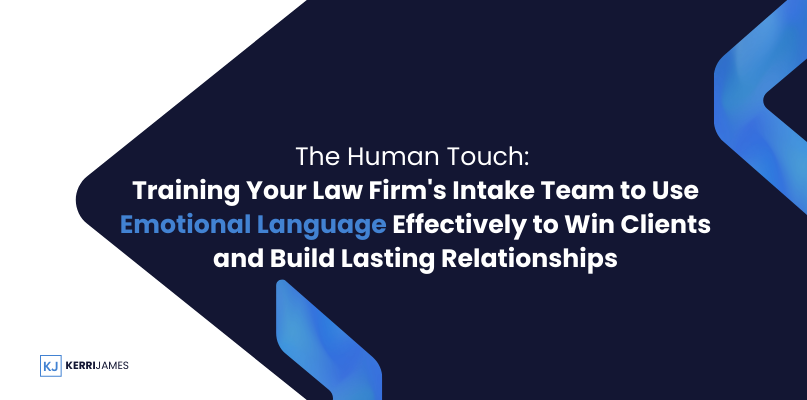In the often-sterile realm of law, where logic, precedent, and legal strategy reign supreme, it’s easy to lose sight of a fundamental truth: clients are not just cases to be managed, they’re human beings grappling with real-life challenges, often facing overwhelming uncertainty, fear, and vulnerability. While the legal profession prides itself on intellectual rigor and objective analysis, the reality is, emotions play a powerful, often subconscious, role in shaping our perceptions, influencing our judgments, and ultimately, guiding our decisions. This is particularly true when individuals are facing life-altering events, navigating the complexities of the legal system, and seeking counsel during times of immense stress – the very situations that bring potential clients to your firm’s doorstep.
This article delves deep into the often-overlooked realm of emotional intelligence in the legal intake process, exploring how mastering the art of emotional language can be the strategic advantage that sets your firm apart, transforming hesitant prospects into confident, committed clients. We’ll move beyond the cold, impersonal language of legal jargon and explore how to connect with potential clients on a deeper, more human level, building trust, easing anxieties, and demonstrating empathy that resonates with their emotional state, not just their legal needs.
Section 1: The Power of the Human Connection – Understanding the “Why” Behind Emotional Language
Before we equip your intake team with the tools and techniques of emotional language, it’s crucial to first understand its profound impact on human connection and decision-making, recognizing why it holds such sway over our perceptions and ultimately, influences our choices, particularly when it comes to matters as personal and impactful as legal representation.
Emotional Language: The Art of Speaking to the Heart of the Client’s Journey
Emotional language is not about manipulating emotions, resorting to cheesy sentimentality, or making promises you can’t keep. It’s about acknowledging that behind every case file, every legal document, and every consultation room door, there’s a human being facing a real-life challenge that has disrupted their world, often leaving them feeling vulnerable, overwhelmed, and uncertain about the future. Emotional language is about recognizing those emotions, demonstrating empathy, and communicating in a way that resonates with their emotional state, building a bridge of understanding and trust that lays the foundation for a strong, lasting client relationship.
Beyond Words: Key Differences Between Emotional Language and Standard Communication
- Shifting the Focus: From Information Delivery to Emotional Experience
Standard communication, particularly in the legal world, often prioritizes conveying information, outlining facts, explaining processes, and ensuring that all the legal bases are covered. While these elements are undeniably important, they often fail to address the emotional experience of the listener, the human being on the other end of the phone or across the consultation table. Emotional language, while not neglecting these essential informational aspects, shifts the focus to understanding and addressing the client’s feelings first, recognizing that logic and reason are often overshadowed by fear, anxiety, and the overwhelming need for reassurance.
- Choosing Words That Resonate: From Clinical Jargon to Empathetic Connection
Emotional language incorporates words and phrases that evoke feelings, paint vivid pictures that engage the listener’s imagination, and resonate with their emotional state, creating a shared experience, a sense of understanding that transcends the often-cold language of legal jargon. Instead of simply stating facts, emotional language seeks to build an emotional connection, making the listener feel heard, understood, and valued as more than just a case number or a name on a file.
- Delivering the Message with Authenticity: The Power of Nonverbal Cues
The way emotional language is delivered is just as important as the words themselves. Tone of voice, pacing, and body language all play a crucial role in conveying empathy, sincerity, and a genuine desire to help. A warm, empathetic tone of voice can instantly disarm anxieties, while a hurried, impersonal delivery can reinforce feelings of being rushed or unimportant.
Why Emotional Language is the Secret Weapon of Client Connection and Conversion
- Building Trust Brick by Brick: The Foundation of Lasting Relationships
When potential clients feel heard and understood on an emotional level, when they sense that you genuinely care about their situation, not just their legal outcome, it creates a powerful sense of trust. It signals that you see them as human beings, not just case numbers, and that you’re invested in guiding them through their legal journey with compassion and understanding. This trust is the bedrock of any successful client relationship, the key ingredient in converting hesitant prospects into paying clients who trust you implicitly with their legal matters.
- Calming the Storm: Reducing Anxiety and Creating a Safe Space for Communication
Legal matters, by their very nature, are often stressful and anxiety-provoking. The fear of the unknown, the complexities of the legal system, and the potential for life-altering outcomes can leave individuals feeling overwhelmed and unsure where to turn. By acknowledging those emotions, validating their concerns, and offering reassurance, emotional language can help to calm anxieties, creating a more receptive and open environment for communication, where clients feel comfortable sharing sensitive information and making informed decisions.
- Enhancing Memorability: Creating Lasting Impressions That Matter
Emotions are powerful memory anchors. When we experience strong emotions, whether positive or negative, those experiences tend to be etched more deeply into our memories. By strategically incorporating emotional language into your client interactions, you increase the likelihood that your firm, and the positive emotions associated with it – trust, empathy, understanding – will be remembered long after the initial conversation, setting you apart from the sea of competitors and positioning your firm as the obvious choice when they’re ready to make a decision.
Section 2: Speaking to the Heart – Key Emotional Language Techniques for Your Intake Team
Now that we’ve established the “why” behind the power of emotional language, let’s delve into the “how,” equipping your intake team with the practical techniques they can implement to enhance their emotional communication skills and create more meaningful, impactful client interactions from the very first point of contact.
- Mastering the Art of Empathy-Driven Phrases: Stepping into Their Shoes, One Conversation at a Time
- Validating Their Experience: “I understand how difficult this must be for you.”
- Acknowledging Their Journey: “It sounds like you’ve been through a lot. We’re here to help you through this, every step of the way.”
- Recognizing the Emotional Weight: “I can only imagine how stressful this situation must be. We’re here to listen and provide the guidance you need to navigate this challenging time.”
By simply acknowledging the client’s emotional state, using phrases that demonstrate empathy and a genuine desire to understand their perspective, you’re creating a powerful connection from the outset, validating their feelings, and building a foundation for open communication where they feel comfortable sharing their concerns and legal needs.
- The Power of Reassurance: Calming Anxieties and Instilling Confidence
- Highlighting Past Successes, Responsibly: “We’ve handled cases similar to yours before with great success. While every case is unique, our experience allows us to anticipate challenges and navigate the complexities of the legal system effectively.”
- Showcasing Your Dedication and Expertise: “You’re in the right hands with our team. We’re committed to fighting for you every step of the way, leveraging our expertise, resources, and dedication to achieve the best possible outcome for your situation.”
- Collaborating Towards a Solution: “We understand your concerns, and we’re here to address them with clarity and compassion. Let’s work together to explore all available options and find the best path forward for your unique circumstances.”
Reassurance is not about making unrealistic promises or offering guarantees that you can’t keep, as this can erode trust and damage your credibility. It’s about providing comfort, instilling confidence in your firm’s abilities, and letting the client know that they’re not alone in this journey. It’s about becoming a trusted advisor, a steady hand guiding them through the complexities of the legal process.
- Trust-Building Language: The Unshakeable Foundation of a Strong Client Relationship
- Transparency and Honesty as Core Values: “Your trust is paramount to us. We’ll be transparent and honest with you throughout the entire process, keeping you informed every step of the way, answering your questions clearly, and addressing your concerns with empathy and understanding.”
- Alignment of Goals – Working Together Towards a Common Purpose: “We’re committed to achieving the best possible outcome for your case. Your goals are our goals, and we’ll work tirelessly to protect your rights, explore all available options, and advocate for your best interests every step of the way.”
- Open Communication – The Key to Building Confidence and Reducing Anxieties: “We’re here to be your trusted guides throughout this process. We’ll be available to answer your questions, address your concerns, and keep you informed of all developments in your case, ensuring that you feel supported, informed, and empowered to make the best decisions for your future.”
Building trust takes time, but using language that conveys honesty, transparency, and a genuine commitment to the client’s well-being can significantly accelerate the process, establishing a solid foundation for a strong, lasting client relationship.
Section 3: From Theory to Action – Training Your Intake Team to Master Emotional Language
Equipping your intake team with the knowledge and understanding of emotional language is just the first step in transforming your intake process. The real magic, the moment when theory transforms into tangible results, happens when these techniques are put into practice, honed through repetition, constructive feedback, and a firm-wide commitment to continuous improvement.
- Role-Playing Exercises: Bringing Emotional Intelligence to Life Through Simulation
Role-playing exercises are an incredibly powerful tool, providing a safe and effective environment for team members to practice using emotional language in simulated client interactions, experimenting with different techniques, and receiving constructive feedback on their delivery. Create realistic intake scenarios, encourage team members to step outside their comfort zones and embody different client personas, and foster a supportive environment where mistakes are seen as learning opportunities.
- Balancing Empathy with Professionalism: Avoiding the Pitfalls of Overpromising
While empathy is the cornerstone of emotional intelligence, it’s crucial to maintain professionalism and avoid making promises that you can’t keep. Train your team to strike a delicate balance between acknowledging emotions, validating concerns, and setting realistic expectations from the outset. Instead of guaranteeing specific outcomes, focus on the process, emphasizing your dedication to exploring all options, and reassuring the client that you’ll fight tirelessly on their behalf to achieve the best possible resolution for their unique situation.
- Cultivating a Culture of Continuous Feedback and Refinement: The Path to Emotional Mastery
Emotional intelligence is not a destination, it’s a journey of self-awareness, skill development, and a commitment to continuous improvement. Encourage your intake team to actively seek feedback from each other, create opportunities for peer-to-peer learning and mentorship, and establish a system for regularly reviewing call recordings to identify areas for improvement, both individually and as a team.
Section 4: Reaping the Rewards: The Impact of Emotional Language on Client Conversions and Firm Growth
Implementing emotional language in your intake process is not just about being “nice” or creating a warm and fuzzy feeling – it’s a strategic approach to client acquisition, a powerful tool that can significantly impact your firm’s bottom line by fostering trust, encouraging conversions, and building a foundation for long-term client relationships that fuel sustainable growth.
From Hesitation to Conversion: How Emotional Language Tips the Scales in Your Favor
- Increased Trust = Increased Conversions: When potential clients feel heard, understood, and valued from the very first interaction, they’re infinitely more likely to trust your firm with their case. Trust is not just a feel-good emotion, it’s the bedrock of any successful client relationship, the key ingredient in converting hesitant prospects into paying clients who believe in your abilities and feel confident in your representation.
- Reduced Price Sensitivity – Building Relationships that Transcend Transactions: Clients who feel emotionally connected to your firm, who see you as more than just legal representatives, but as trusted advisors and empathetic advocates, are less likely to be driven solely by price. They’re investing in more than just legal services, they’re investing in a relationship, a sense of security, and the confidence that their case is in capable and caring hands.
- Enhanced Client Loyalty – Turning Satisfied Clients into Powerful Advocates: Clients who feel understood and valued, who have experienced the power of emotional intelligence firsthand, are more likely to become loyal advocates for your firm, referring friends, family, and colleagues facing similar legal challenges. They become walking testimonials to your firm’s commitment to client-centricity, amplifying your reach and reputation within the community.
Case Studies: Real-World Examples of Emotional Intelligence in Action
*Note: names of firms are anonymized
Numerous law firms across the country have successfully integrated emotional intelligence principles and the power of emotional language into their intake processes, experiencing a tangible, measurable impact on client conversions, satisfaction rates, client retention, and overall firm growth. These forward-thinking firms recognize that legal expertise alone is no longer enough to thrive in today’s competitive market. They prioritize empathy-driven training programs for their intake teams, empowering them to connect with clients on a deeper level, build trust from the first interaction, and create a client-centric experience that differentiates them from the competition and fosters long-lasting relationships built on trust, mutual respect, and shared success.
The Verdict: The Transformative Power of Emotional Connection – Elevating Legal Intake From Transaction to Relationship
In the complex and often daunting world of legal services, where clients arrive at your doorstep burdened with anxieties, uncertainties, and a profound need for guidance, mastering the art of emotional connection is no longer a luxury, it’s the key to unlocking a steady stream of loyal, long-term clients who trust you implicitly with their legal matters. While legal expertise, strategic thinking, and courtroom prowess are undeniably essential, they’re often overshadowed by the human element, the need for clients to feel heard, understood, and valued on a deeper, more personal level.
The strategies and techniques we’ve explored in this article, from empathy-driven phrases and reassuring language to trust-building communication and role-playing exercises, are designed to equip your intake team with the tools of emotional intelligence, empowering them to create a client-centric experience that resonates with the heart as well as the mind. It’s about recognizing that behind every case file, every legal document, and every consultation room door, there’s a human being facing a real-life challenge, often grappling with fear, vulnerability, and the overwhelming need for a steady hand to guide them through the complexities of the legal system.
By embracing emotional intelligence, you’re not just adding a touch of “nice” to your intake process, you’re implementing a powerful strategic advantage that can transform your firm’s client acquisition, retention, and overall success. When potential clients feel heard, understood, and valued from the very first interaction, a profound shift occurs. Trust is established, anxieties are eased, and a connection is forged that transcends the transactional nature of legal services, paving the way for a lasting relationship built on mutual respect, shared goals, and a deep understanding of the client’s unique needs and desired outcomes.
Think of it this way: clients who feel emotionally connected to your firm are less likely to be swayed by price comparisons or lured away by competitors offering a slightly lower hourly rate. They’re investing in more than just legal services, they’re investing in a relationship, a sense of security, and the confidence that their case is in capable and caring hands. They become less sensitive to price fluctuations, more forgiving of minor setbacks, and ultimately, more likely to remain loyal clients, referring friends, family, and colleagues, amplifying your firm’s reach and reputation within the community.
The real-world results speak for themselves. Numerous law firms across the country have embraced the power of emotional intelligence, implementing empathy-driven training programs for their intake teams and witnessing a tangible impact on their client conversions, satisfaction rates, and overall firm growth. They’ve recognized that in today’s competitive legal landscape, where clients have more choices than ever before, emotional intelligence is not just a feel-good strategy, it’s a smart business decision that can set you apart from the crowd, fostering a culture of client-centricity that attracts, converts, and retains high-value clients.
The takeaway is clear: mastering the art of emotional connection is not just about being “nice,” it’s about transforming legal intake from a transactional process into a relationship-building opportunity, creating a foundation of trust, understanding, and shared success that benefits both your clients and your firm. By equipping your team with the tools of emotional intelligence, empowering them to speak to the heart of the client’s journey, you’re not just winning cases, you’re winning over clients, creating lasting connections that fuel sustainable growth, positive word-of-mouth referrals, and a reputation for excellence that extends far beyond the courtroom walls.










